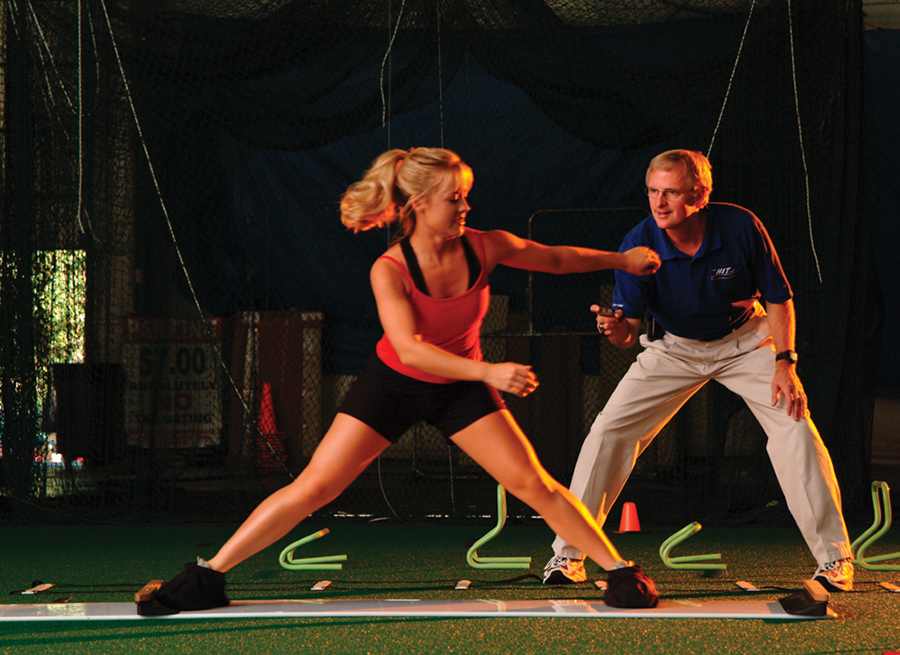From hard-core athletes to those hoping to shed extra pounds, the HIT Center offers a fitness solution for the highly-motivated individual.
By Abby Perdue
HQ 45 | AUTUMN 2002
At every corner of modern America, fast food joints tantalize passersby with high-fat hamburgers and greasy French fries. Biking, walking and other forms of transportation are antiquated, replaced instead by cars and trucks. In fact, labor-saving machinery has alleviated nearly every physically strenuous activity, while both children and adults are increasingly entertained by television and computers. Perhaps due to America’s love affair with leisure, a recent study from the U.S. Centers for Disease Control and Prevention claims that the number of obese Americans has skyrocketed from one in eight, to nearly one in five.
Yet from the ashes of this national crisis comes Huntington’s very own fitness solution. Debuting almost two years ago, the HIT Center is a 10,000 square foot facility specializing in weight loss and specialized sports training. Its founder, Dr. Terry Shepherd, is a professor of Exercise Physiology at Marshall University and it was in the classroom where his innovative idea came to life.
Hoping to fill the huge gap between physiological theories of exercise and their practical application, Shepherd envisioned a revolutionary fitness center that used scientific theories to target and fulfill his clients’ specific fitness needs.
Whether he was working with a finely-tuned professional athlete hoping to increase his speed and agility, or an out-of-shape yuppie looking to turn back the hands of time, Shepherd wanted results. After years of study, his research culminated with a four month trip across America where he analyzed various fitness programs, uncovering what works and what doesn’t. Upon his return, he formed a quasi-alliance with Huntington Physical Therapy and the HIT Center was born.
Though Shepherd warns that persons experiencing health problems should consult a physician before starting his regimen, he also asserts that the HIT Center is perfectly safe for those with former heart problems, surgery and diabetes. In fact, Frank Horton, a computer programmer who has lost 110 pounds in Shepherd’s “Lighten-up” Weight Loss Program, was unable to do other activities due to back problems, and found the center’s workouts to be difficult but doable. MacKenzie Hoppe, a figure skater who had suffered from ankle and knee injuries in the past, also feels comfortable with her training regimen.As its name implies, the High Intensity Training (HIT) Center is no day at the park. Instead, it is a challenging process that is, in Shepherd’s opinion, ideal only for a highly motivated person. Interestingly, however, Shepherd’s center experiences a wide variety of clientele ranging from age five to 77.
From Prestonsburg to Parkersburg, clients flock to the center at a doctor, friend or even coach’s suggestion. On any given day at the center, located at 2240 Fifth Avenue, you will find people from every walk of life. From seven year old tennis prodigies, to college football stars, to silver haired senior citizens, they all come to the Hit Center with the same goal in mind: utilizing Shepherd’s scientific expertise to better themselves physically.
Your work at the HIT Center begins with scientific testing of your overall fitness level and abilities. Under Shepherd’s direction, staffers evaluate and record your weight, body fat percentage, heart rate, VO2 max (or your cardiovascular threshold), strength, balance and agility. The list of tests can grow even longer depending on your goals. Most people then sign on for 10 exercise sessions to learn the HIT Center system, yet most participants continue training beyond the initial regimen. In fact, nearly every person interviewed for this article has attended the center since its debut and plans to continue training there in the future.
Although the “Lighten Up” Weight Loss Program and less expensive HITFIT program for athletes cost severalThe center is open from 6 a.m. to 9 p.m. and because of these flexible hours most participants easily fit the workout into their busy schedules.
hundred dollars to complete, Jared Jones, a Spring Valley student and champion golfer, claims that both the time and money are well-spent. Hoppe adds that the center’s personal training and techniques are far cheaper than other private lessons and programs she has tried.

Yet what makes Shepherd’s HIT Center so special? Perhaps the HIT Center is unique because it offers distinct features including personal trainers and state-of-the-art equipment.
Not surprisingly, after receiving a weight loss assessment as a Christmas present, Sherry Hanshaw, a 44-year old mother of three, entered the HIT Center and was both impressed and bewildered by the unusual techniques she observed. Using a $58,000 computer known as the Metabolic Cart, HIT staff members evaluated Hanshaw’s blood pressure, heart rate, blood lactic acid levels and more during various activities, designing an “exercise prescription” just for her.
At each session thereafter, various biological factors are constantly monitored, and her program is repeatedly modified, always driving her to reach her maximum heart rate and full fitness potential.
The assessment, which may also include dietary counseling, cardiopulmonary testing and a measure of one’s Resting Daily Energy Expenditure, does not end there. Instead, Shepherd has amassed an array of high-tech equipment to achieve each client’s fitness goals. For example, a Wingate bike, identical to those used by Olympians, measures the watts/kilograms of power generated by an athlete’s cycling. An enormous treadmill, modified by Shepherd, reaches speeds of 25 mph, employing safety harnesses to hold fast-moving, hard-core athletes to the treadmill’s sliding track. Three other treadmills operate under various protocols, including Energy Systems Training that forces clients to run hard for two minutes and rest for one minute, and Directional Training, that allows clients to run sideways and backwards against a changing gradient. The short spurt of high intensity is followed by a timed recovery or “warm down” on another slower-moving machine.
Outside the main exercise room lies another world of unique equipment. For example, an Astroturf course is used for more than 30 agility-training activities and is a favorite among football players. A 25 square foot sandbox offers foot resistance, forcing an athlete’s leg muscles to do all the work. Aside from foot speed, vertical jump and weightlifting exercises, Shepherd also uses kinesiology (the study of human bodily movement) to perfect novel methods of improving golf and baseball technique.By employing a space-age, bubble-like “bodpod,” one of only 200 in the world, Shepherd even measures clients’ body composition including a muscle-to-fat ratio. Due to this amazing science and state-of-the-art equipment, it is no wonder that Hoppe was “surprised to find something like this in Huntington.” Perhaps the HIT Center really is just what the doctor ordered.
Yet the unique equipment and revolutionary science that support the training center are not the only variables in Shepherd’s formula for success. Instead, his center also enjoys a qualified staff, including six part-time personal trainers and four full-time employees. According to Jones, the staff only pushes people relative to their own abilities. Mostly comprised of Marshall student interns, the staff is overseen by Dr. Shepherd and is uniformly praised as friendly and knowledgeable.
Personal trainers are the most dynamic aspect of Shepherd’s staff. At each session, a client is assigned one trainer who motivates, monitors and oversees each of his or her workouts. As Hoppe notes, “nothing compares to one-on-one training with someone who is knowledgeable.” In speaking of her trainer, Hanshaw even admits that, “he got me through the tough times.”
Horton’s praise of the center is not surprising when one considers that in only 15 months he has more than doubled his aerobic capacity. In addition, the weight he has lost has helped alleviate the pressure on his vertebrae, eventually lessening his back pain. Similarly, Sherry Hanshaw lost 30 pounds in only three months and has trained at the center ever since.As Hanshaw’s confession suggests, the HIT Center is a definite challenge that may not be for everyone.
Shepherd admits that his program may seem daunting at first but is usually embraced after clients see results.

Weight loss is not the only benefit. Instead, athletes such as Jones and Hoppe noticed increased strength, energy and endurance after the first few months of training.
According to Shepherd, the greatest benefits of high intensity training are more than skin deep. Increased exercise may decrease the risk of heart disease – a medical condition responsible for 32.9 percent of West Virginian deaths in 1998. Exercise may even have positive implications upon emotional health because as Hoppe explains, “when you reach goals that you never thought that you could reach, you can’t help but feel better about yourself.”
But is the HIT Center truly a secret weapon in the battle for fitness? Though most athletes and some “Lighten-up” participants do combine their HIT workout with other forms of activity, most agree that the key aspect of their training is Shepherd’s center. In fact, it is to the center that Jones (West Virginia’s Golfer of the Year) attributes his recent athletic success. After working with Shepherd during the past year, Jones added 10 pounds of muscle to his physique and 30 yards to his drive, averaging close to 300 yards off the tee. He just signed a letter of intent to play golf in college at Ohio State, one of the most elite programs in the nation.
Offering a private setting, flexible hours, state-of-the-art equipment and personal attention, the HIT Center enjoys ever-growing popularity and success. Consequently, Shepherd is planning to open HIT Centers nationwide through a series of license agreements (or franchises), and is confident that his dynamic formula will meet the nation’s growing fitness concerns. In fact, a second HIT Center is set to open in Jacksonville, Florida this fall, and other major cities that plan to license the name and protocol include Lexington, Kentucky, Spokane, Washington and Charleston, South Carolina.
His current clients support his plans for expansion, hoping that others may enjoy the benefits that they have long experienced. Not surprisingly, some participants such as Hoppe have even expressed interest in someday operating HIT Centers of their own.
Shepherd has created a formula for success by morphing modern science with traditional knowledge – making his innovative HIT Center a huge hit after all.
| One Hour at the HIT Center |
| Here’s a typical one hour workout at the Hit Center, located at 2240 Fifth Avenue in Huntington. To schedule an appointment, call 304-529-4482. |
| 8:00-8:03 |
| Weigh in, strap on your heart monitor and warm up on the treadmill by running sideways and backwards on a slight gradient at a medium pace. |
| 8:03-8:08 |
| Intense stretching with assistance from your personal trainer to help prevent injury and improve overall flexibility. |
| 8:08-8:38 |
| Now the fun begins. Brace yourself as your personal trainer guides you through an intense 30 minute cardiovascular workout, constantly monitoring your pre-determined heart range. Depending on the day of the week, you may be required to perform: (A) Energy System Training or ESTs – where you run hard for two minutes and then recover at a slower pace for one minute; (B) LSDs or Long, Slow, Distance – where you run at a slower pace but with no recovery time incorporated; (C) Directional Training – where you run sideways, backwards and sideways again on the treadmill. You will work hard for one minute and then recover at a slower pace for one minute; (D) Slideboard – where you place slick booties over your running shoes and slide back and forth on a plastic board, pushing off from each side much like an Olympic speedskater. You will work hard for two minutes and then rest for one minute. If your trainer feels like torturing you some more, he may have you run a series of obstacle course drills over small hurdles. There’s a veritable plethora of other exercises at the HIT Center designed to get your heart rate up and make you sweat and gasp for air. This is just a sampling. |
| 8:38-8:55 |
| Your cardiovascular workout is complete and you are sweating buckets. You gulp down some water and head for the strength training portion of your workout. Here your personal trainer may run your through a fast-paced series of weight lifting movements including the bench press, curls, military press, tricep pushdowns, chin ups or rows. The HIT Center also prides itself on finding innovative ways to increase your strength from utilizing a large sandbox to an explosive exercise called land minds – don’t ask. |
| 8:55-9:00 |
| Time to finish up strong on your core – or your midsection. Here, your personal trainer has a vast array of exercises to strengthen and tone your abdominal muscles. He may have you lie on an exercise ball and perform modified crunches. He may place you on a decline bench and force you to catch a heavy medicine ball and toss it back to him…repeatedly. It all depends on your trainer, the day of the week and how much gas you have left in your tank. Congratulations, you made it. |




